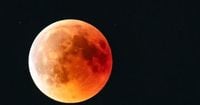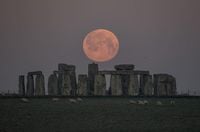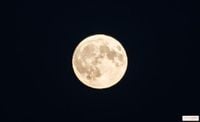As June arrives, skywatchers across the Northern Hemisphere are gearing up for a celestial event that has captivated cultures for centuries: the full Strawberry Moon. This year, the moon will put on a particularly striking show on the night of June 10 and into the early hours of June 11, 2025, offering a rare spectacle that won’t be seen again until 2043.
The name "Strawberry Moon" traces back to the Native American Algonquian tribes, who named it to mark the strawberry harvest season in June. It’s important to note that the moon’s name has nothing to do with its color. Instead, it reflects the timing of the ripening of wild strawberries in northeastern North America, a crucial seasonal marker for many indigenous cultures. Other societies have given this lunar event names like the Blooming Moon, Green Corn Moon, Birth Moon, or Hatching Moon, each highlighting seasonal agricultural or natural phenomena.
Technically, a full moon occurs when the moon is positioned directly opposite the sun as seen from Earth, fully illuminating its surface from our vantage point. For 2025, observers in New York will see the moon reach full illumination at precisely 3:44 a.m. EDT on June 11. However, the best time to observe the moon is right after sunset on June 10, when it rises in the southeast, glowing brightly against the twilight sky.
One of the most fascinating aspects of this year’s Strawberry Moon is its unusually low path across the sky. According to EarthSky.org, this full moon will travel lower than it has in decades, a result of the moon’s tilted orbit being influenced by the sun’s gravitational pull. This phenomenon causes the moon to take a lower trajectory near the summer solstice, when the sun reaches its highest point in the sky. Stargazers in the UK and other parts of Europe will witness the moon rising between 9:00 p.m. and 9:30 p.m. BST on June 10, with its peak full illumination occurring the following morning at 8:43 a.m., after sunrise.
This low elevation has a dramatic effect on the moon’s appearance. When the moon hangs near the horizon, it must shine through a thicker layer of Earth’s atmosphere compared to when it is overhead. This longer journey causes a phenomenon known as Rayleigh scattering, where shorter wavelengths of light—blues and greens—are scattered out, leaving the longer wavelengths such as reds and oranges to dominate. Additionally, dust, smoke, and pollution near the ground further absorb and scatter light, enhancing the moon’s reddish or coppery tint. This effect is similar to why sunsets appear red and why lunar eclipses, often called "blood moons," take on their eerie crimson glow.
For many, the Strawberry Moon will appear larger than usual due to the “moon illusion,” a curious trick of the human brain that makes the moon seem bigger when it’s close to the horizon than when it’s high in the sky, even though its actual size remains constant. This illusion, combined with the moon’s low, reddish glow, makes for a breathtaking sight that has inspired countless photographers and sky enthusiasts.
Speaking of photography, capturing the Strawberry Moon can be a rewarding challenge. Experts recommend finding a location with an unobstructed view of the southeastern horizon and planning to stay for several hours to catch the moon’s rise and journey across the sky. For those aiming to photograph the moon itself, a telephoto lens or telescope is essential to capture its detailed surface features. However, if the goal is a landscape shot that includes the moon alongside landmarks, such specialized equipment might not be necessary, though preparation is key to framing the perfect shot.
In the UK, this lunar event is particularly special because the Strawberry Moon will not appear this low on the horizon again until 2043. This rarity adds an extra layer of excitement for astronomers and casual observers alike, as the moon’s crimson hue and low arc promise a memorable spectacle.
Across the United States, the Strawberry Moon will be visible on June 11 at 3:44 a.m. EDT in New York, with the best viewing opportunity starting at moonrise on June 10 after sunset. Meanwhile, in the UK, the moon will be fully illuminated at 8:43 a.m. BST on June 11, but the most dramatic viewing comes at dusk on June 10 when the moon rises and casts its warm glow low in the sky.
Looking ahead, the UK will experience additional full moons throughout 2025 on July 10, August 9, September 7, October 7, November 5, and December 5, offering plenty of chances for skywatchers to enjoy lunar wonders. Yet, none will quite match the unique allure of this year’s Strawberry Moon with its rare low altitude and reddish tint.
Whether you’re an avid astrophotographer, a casual stargazer, or just someone who appreciates nature’s rhythms, the 2025 Strawberry Moon is a celestial event not to be missed. It’s a perfect reminder of how our ancestors used the moon’s phases to mark time and seasons, connecting us to the natural world in a way that transcends centuries.
So, mark your calendars for the evening of June 10, step outside, and look southeast as the sky darkens. You might just catch a glimpse of the moon bathed in strawberry hues, a glowing orb that has been enchanting humanity for generations, shining low and red in the summer night sky.






